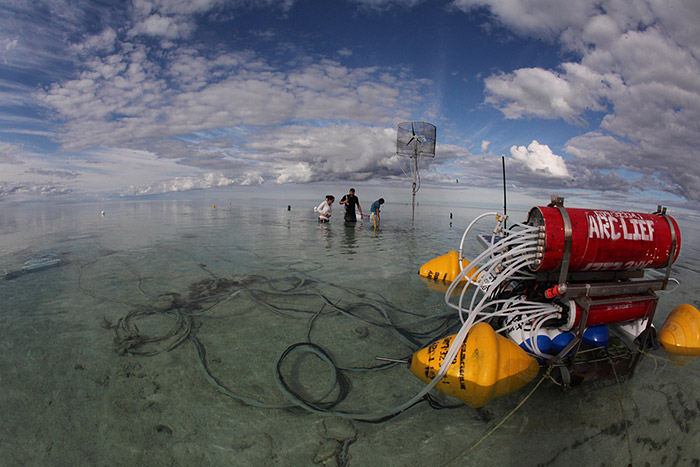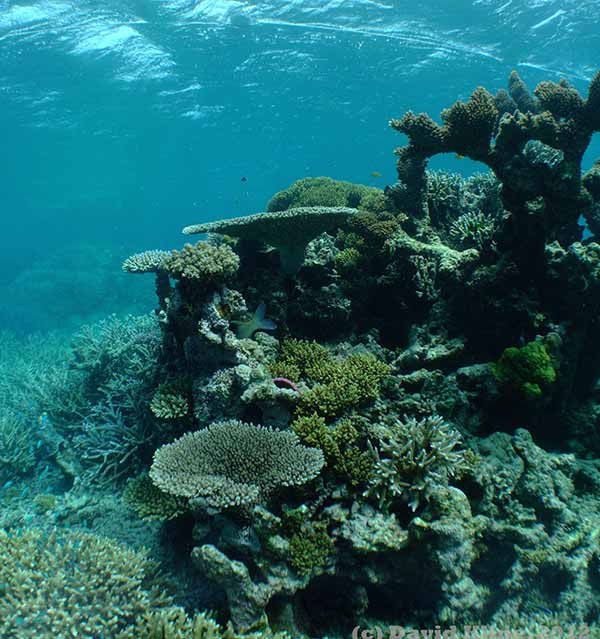
New Study Could Pave Way for an Ocean Acidification Early Warning System for Coral Reefs
Scripps-led team offers improved approach to monitor health of coral reef ecosystems
Published Date
By:
- Mario Aguilera
Share This:
Article Content
A new study on Australia’s Great Barrier Reef showed that corals are continuously exposed to two key climate change-related stressors throughout the year, but not necessarily at the same time. The results can help scientists better monitor the exposure of coral reef ecosystems to global climate change.

The researchers collected information on seawater at Heron Reef using an integrated sensor network. Credit: David I. Kline
For six months, an international team led by scientists at Scripps Institution of Oceanography at UC San Diego collected high-resolution measurements of temperature, pH, carbonate chemistry, and other key environmental parameters on the Heron Island coral reef flat, located in the southern Great Barrier Reef. The results revealed that exposure to low pH and high water temperature occur in a non-synchronized way, which suggests that coral reefs could be subject to stressful conditions more often than scientists previously thought.
“Corals are being exposed to environmental stressors at different times, which could allow a reef some recovery time between stress events, such as a warm-water bleaching event,” said David Kline, project scientist at Scripps Oceanography and lead author of the new study. “On the other hand, there is also a greater chance that stress events occur during times of high energy demands, such as reproduction.”

Heron Reef flat, a coral reef located in the southern part of Australia’s Great Barrier Reef. Credit: David I. Kline
The study, published in the June 3 issue of the journal PLOS ONE, is the first to provide a high-resolution, long-term dataset of seawater carbonate chemistry on a coral reef flat, or the shallow back reef close to shore. During the 2010 experiment, night-time pH levels on the reef flat were often lower than pH values predicted by the Intergovernmental Panel on Climate Change for the open ocean in 2100.
“We can use this new information to develop a warning system for both temperature and pH stress events on coral reefs,” said Kline. “In a world with growing CO2 levels, that will become more important.”
Climate change and ocean acidification are widely considered to be the largest threats to coral reefs globally. To monitor ocean acidification, scientists measure the pH of seawater, which decreases as the oceans absorb carbon dioxide from the burning of fossil fuels. In the oceans, chemical reactions convert a portion of the CO2 into carbonic acid, thereby lowering the pH.
The research team hopes that these results illustrate the importance of including both temperature and pH in computer models that predict when coral reefs are most likely to be impacted by these types of stress events.
The study included researchers from the University of Queensland in Australia, Stanford University, Conservation International, Carnegie Institution, University of Hawaii, University of Alaska, Institut Océanographique Paul Ricard, and the Hebrew University of Jerusalem.
The research was funded by Australian Research Council (ARC) Linkage Infrastructure, Equipment and Facilities grants, an ARC Centre of Excellence grant, a Queensland Government Smart State Premier's Fellowship, National Science Foundation grants, and the Pacific Blue Foundation.
Share This:
You May Also Like
Stay in the Know
Keep up with all the latest from UC San Diego. Subscribe to the newsletter today.


